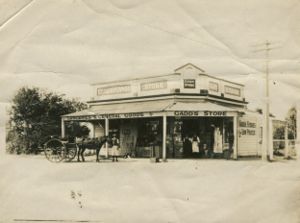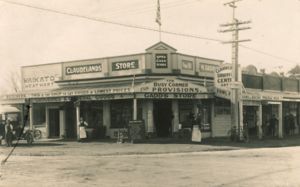- Profile
- Images
Location: Hamilton, New Zealand
Surname/tag: Gadd-88
Bernard Gadd - Gadd’s grocery shop was the largest of a block of shops on the corner of Heaphy Terrace (now Grey St) and Te Aroha St. The main entrance was on a diagonal across the corner. At the corner was a green painted horse hitching post (still there in a new position) Down the Te Aroha St side next to the shop was a barber’s and at least one other shop, at one time the Misses Rowe’s' home cookery. The other small shop on the Heaphy Terrace frontage was a butcher. Next to the butcher was a metal driveway. At a short distance down it was one (I think) petrol pump and the drive-way ended at the provisions store, a large wood building on concrete base raised about a metre so that vans and trucks could unload onto a small loading dock. In this place were kept the foodstuffs awaiting transfer to the shop- the large cheese wheels in cloth, the sacks of flour and bags of grain, the compacted mass of dates and so on. It was heaven for rats.
On entering the shop there was usually a small display of seeds and garden or maybe also hardware items immediately to the left, then beyond that along the wall to the left a counter where bread was sold, usually white loaves, always unwrapped. Beyond it was a small doorway onto Heaphy Terrace. On the left hand side of the shop was the office where Frank often worked on accounts and orders and so on. Where that wall and the one facing the bread counter met was a doorway into the storeroom behind the shop. Between the office and that doorway was a customer filing system comprising a flip down set of hardboard panels to which accounts were attached with clips, and often Frank was seen dolefully examining the overdue accounts. A long counter ran in front of the longest wall attached to which were long rows of shelves reaching to ceiling. A moveable ladder on a runner like a librarian’s ladder could be moved along the shelves. The trick was to remember where the different kinds of goods were shelved. At the end of the counter was a huge refrigerator for butter and cheese and perhaps eggs, and in a recess at the top of that the shop's 'takings’ were kept and the Gladstone bag for Grandpa Herbert Gadd to take to the bank each day. The fourth wall also had a counter in front of it and on this counter were the bacon slicer machine and a simple wire with toggle which was the cheese slicer, and beside them a weighing machine.
The shop stocked an amazing array of things from gardening tools and seeds to tea - at one stage anyway Frank and David packed their own blend of leaves; tinned foods, fresh foods, kerosene, cleaning products, biscuits, lawn mowers, rakes, spades, household products of all kinds probably including simple china, tilly lamps, long cakes of taniwha soap that had to be cut into shorter lengths. David used to talk of how they’d tried to persuade Pearson to leave out the carbolic acid in his Pearson's sandsoap and how the factory (now a wool scourers) eventually had to close down because people no longer wanted the strong carbolic. In short, it was very much a general store which for much of its life delivered boxes of orders by van as far as Newstead or by bike. David was the sign writer and prided himself on his blue backgrounds and fancy lettering and figures.
The staff were Frank, Dad [David] and in later years Doris plus usually a man or boy.
Behind the main shop was the large, dim and odour-filled provisions store with its small upper deck. Here was the row of grain bins for wheat, barley, flour, probably sago, rice, dried peas, and lentils. The bags of flour, the tins of kerosene, paraffin or turps, the boxes of tea, and all products too bulky, dusty or smelly to keep in the main shop. Weevils were a scourge, getting into flour, dates, porridge and so on.
Grocery was a labour intensive, physically tough trade. Goods were usually bulk supplied and had to be put into the smaller quantities that customers wanted by the grocers. The cheese wheels were rolled into the backroom, the outer cloth cut away and the inner muslin torn off, the wheels cut into chunks to store in the fridge to await the customer, smaller hunks resting on a wooden square on the counter. There were two main varieties, tasty and mild cheddar. Grain and flour had to be brought in by the little wheeled trolley and emptied into the bins. Dates had to be cut into smaller blocks, kerosene and other fuels that came in bulk transferred into bottles or kept ready to decant into the customer's own container. And shelves had to be restocked which involved carrying quantities up the ladder. Annual stocktaking was a nightmare of constant moving up and down ladders and calling down quantities. During the Second World War rationing made things tougher. I remember the dining room table at home heaped with the ration slips pulled out of ration books, mum and dad counting away. The ration totals had to square with the amounts sold. Petrol was also rationed and that brought a court fine when it was found that the ration slips didn’t quite square with the sales, though dad was always angry about that and the judge’s unfavourable remarks, saying that in fact the discrepancy was on the side of the state not the shop so if there was as the judge claimed signs of dishonesty it certainly wasn't by the Gadds!
The cardboard cartons of orders customers left at the shop or phoned in were piled up in corners then sent out in the van or bicycle. They had to be delivered to the back door or housewives were displeased.
Since the variety of goods sold was so extensive – sometimes even stocked for a single customer wanting out-dated products - there was always considerable stock in hand. This must have been a strain on the shop’s finances. However, the shop survived the Depression. As time went on rival groceries opened up, including a small member of the Marriott’s chain almost opposite, which eventually went out of business. The next largest grocer was probably at the Five Cross Roads, and those in Hamilton East. As the customer base shrank, there were fewer deliveries and only the three Gadds as staff.
Southwell school students came to buy a penn'th of broken biscuits, some of which were broken by the staff in order to keep the kids happy because too few biscuits actually got broken to meet the demand. (I suspect they made a loss on those transactions.) Counters had to be scrubbed down with sandsoap, the floors were bare timber, the light bulbs dim. Many goods were sold in brown paper bags ... I remember a flour bag ripping and me running back to a displeased parent in the shop with a white trail dribbling behind me. Shop hours were long, about 8-5 on weekdays, late night Friday plus Saturday mornings for many years. I have no idea how they continued to work so many years since none of them were in first class health. My father had to resign in the early 1950s unable to stand the pain any longer of climbing the ladders and being on his feet all day.
The Gadds were such honest business people that few people could believe they also weren't into over-charging, under-weighing etc. But they paid themselves low wages - I think dad got about $8 a week – and kept profit margins low, and tried to accommodate the quirks of long-standing customers. The values dear to the three Gadds were different from many other businesspeople in the city who assumed that they too must be ardent National Party supporters and I recall one election day (held before a law change on weekdays) women running into the shop to pass on the bad news that they feared National wasn’t doing well. The war years were tough, with not only shortages of things like biscuits but many products were unavailable such as chocolate, lollies and rice and basics like butter and sugar and tea were rationed.
The shop belonged to the Four Square group, individually owned grocer shops sharing in a wholesaling arrangement run, I think, by Burgess Fraser. After the shop was sold it was torn down and a more modern style supermarket built.
Celia Reed – The hardest thing I found when working in the shop was adding up the prices of goods bought – sometimes up to 20 items e.g. 1/3 ½ d and 15/6 etc in front of a customer; sometimes the lady would be talking to you while you tried to add up or else watching carefully in case you made a mistake! Frank and David could add up so quickly (and I expect accurately too) and made it look easy.
Rosalie Williams – The family store was an exciting place for me as a child. I remember the long counters and how busy the shop was. Aunty Dorrie worked there then with her brothers David and Frank. I remember the big tins of loose biscuits in Gadd’s Store and the happy childhood memory of Aunty Dorrie letting me tuck in to the tin of broken biscuits kept under the counter.
- Login to request to the join the Trusted List so that you can edit and add images.
- Private Messages: Send a private message to the Profile Manager. (Best when privacy is an issue.)
- Public Comments: Login to post. (Best for messages specifically directed to those editing this profile. Limit 20 per day.)
- Public Q&A: These will appear above and in the Genealogist-to-Genealogist (G2G) Forum. (Best for anything directed to the wider genealogy community.)



